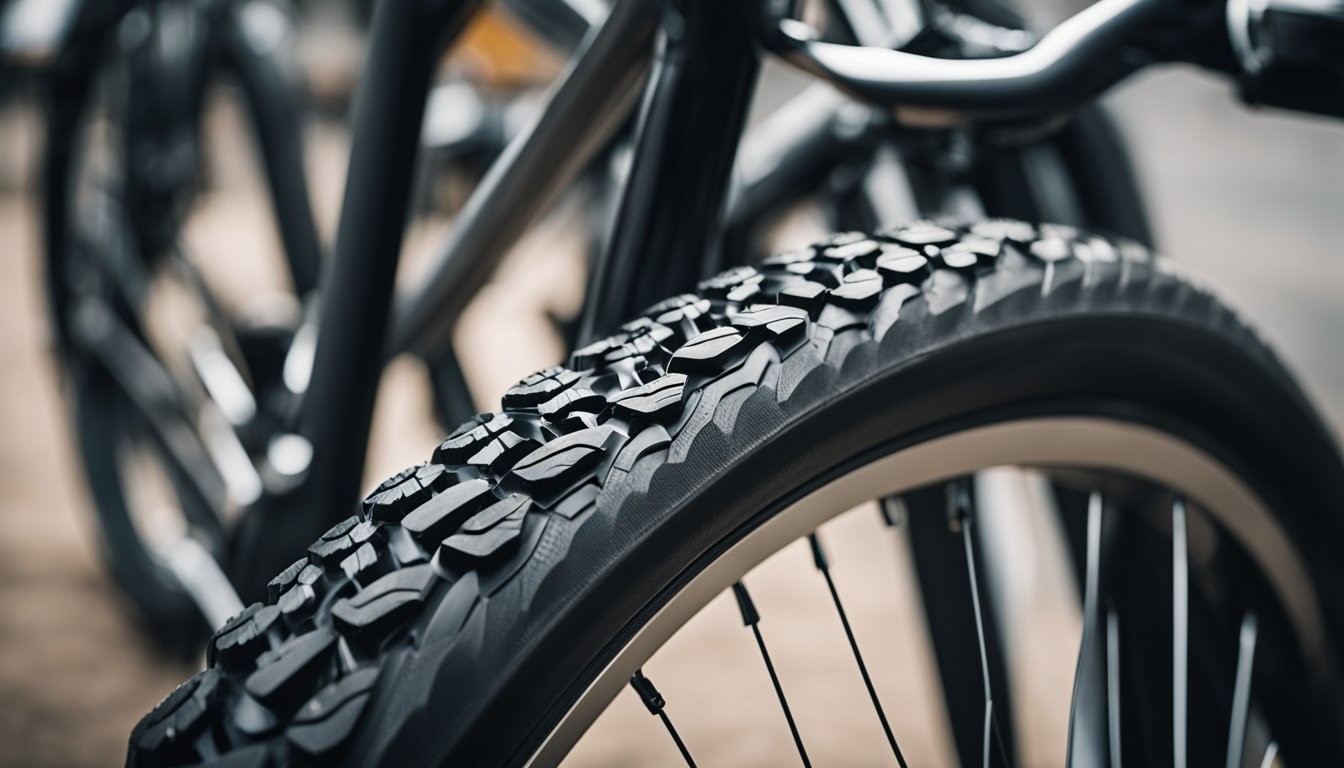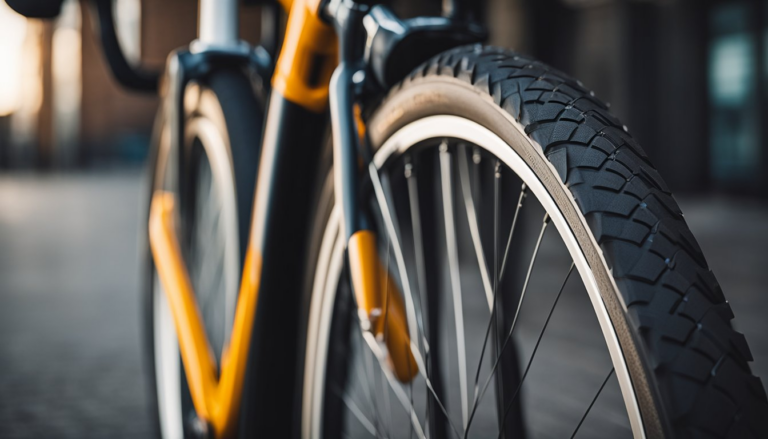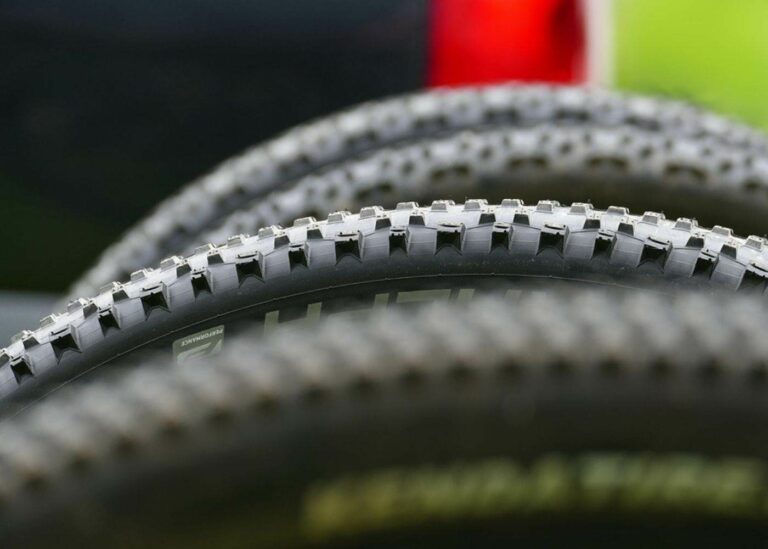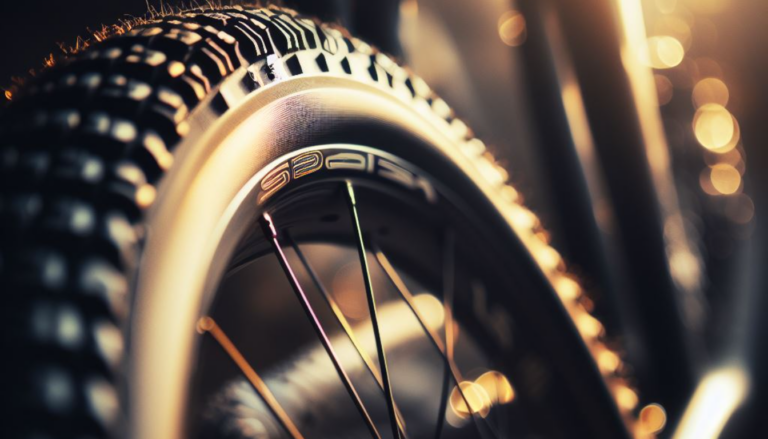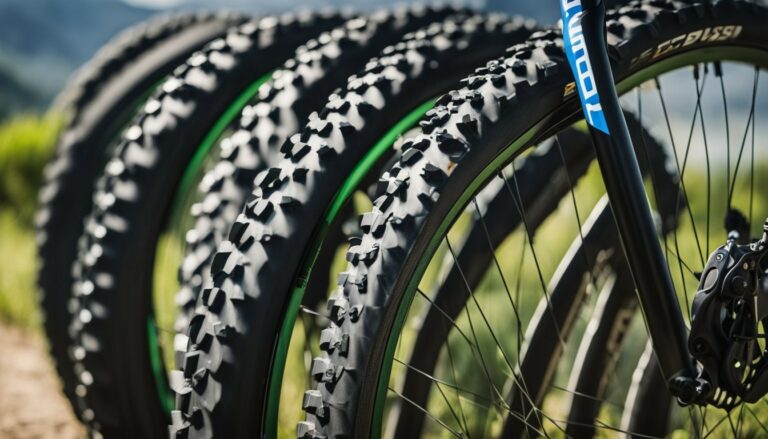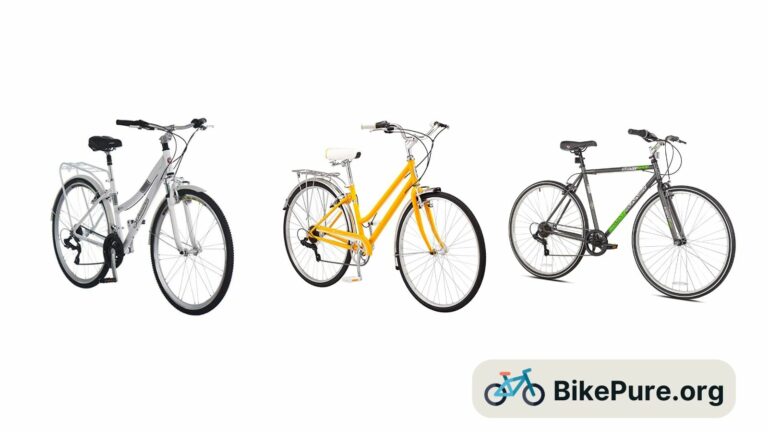Guide to Hybrid Bike Tires: Essential Tips for Optimal Performance
Hybrid bike tires are unique as they combine the best features of both road bike and mountain bike tires, offering versatility and comfort on various terrains.
Considering the wide range of hybrid tire options available, it’s important to understand the anatomy, materials, and tread patterns to make an informed decision for your cycling needs.
Key Takeaways
- Hybrid bike tires offer versatility and comfort on various terrains, thanks to their unique features.
- Familiarity with anatomy, materials, and tread patterns is essential for choosing the perfect hybrid bike tire.
- Environmentally friendly and long-lasting options contribute positively to both your cycling experience and reducing your carbon footprint.
Understanding the Anatomy of a Hybrid Bike Tire
| Feature | Tube Tires | Tubeless Tires |
| Structure | Have an inner tube | No inner tube, use sealant |
| Puncture Risk | Higher (tube can be punctured) | Lower (sealant can self-seal punctures) |
| Weight | Generally heavier | Lighter, due to lack of tube |
| Pressure | Can run at higher pressures | Can run at lower pressures for comfort |
| Maintenance | Easier to replace or repair | More complex setup, but less maintenance |
1. Tread Pattern
The tread pattern on a hybrid bike tire is designed to provide optimal performance on a variety of surfaces. These tire patterns are usually a mix of smooth, continuous center rib and more aggressive side knobs.
The central rib provides low rolling resistance on paved surfaces, while the side knobs enhance grip and traction on loose terrain and off-road conditions. Hybrid bike tires often outperform dedicated road or mountain bike tires when it comes to versatility.
2. Sidewall
The sidewall of a hybrid bike tire refers to the outer edges of the tire, between the tread pattern and the bead. It plays a significant role in the overall stability and durability of the tire. Sidewalls are usually made of strong materials, such as nylon or other synthetic materials, to ensure the tire maintains its shape and provides protection against punctures. Some hybrid bike tires also feature a reinforced or puncture-resistant sidewall for added durability.
3. Bead
The bead of a hybrid bike tire is the part of the tire that connects to the rim of the wheel. There are two types of beads: nylon or wire beads. Wire beads are more durable and less prone to stretching, while nylon beads are lighter-weight and foldable, making them easier to transport and store. The bead’s main function is to keep the tire securely attached to the wheel rim.
4. Casing
The casing of a hybrid bike tire consists of the main body of the tire, which is usually made from several layers of fabric, commonly nylon. These layers, called plies, provide the structure and strength of the tire. A high-quality hybrid bike tire will have more plies, which improves durability, puncture resistance, and overall performance.
5. Tube versus Tubeless
Hybrid bike tires can be either tube or tubeless, each with its own advantages and disadvantages. Tube tires consist of an inner tube, which inflates and provides the tire’s structure. If punctured, the inner tube will deflate, causing the tire to go flat.
Tubeless tires, on the other hand, are filled with a sealant that allows the tire to self-seal any punctures. This design reduces the risk of flats and allows for lower tire pressure, improving comfort and traction on various surfaces. The decision between tube and tubeless tires depends on personal preference, riding conditions, and budget.
Exploring Types and Dimensions of Hybrid Bike Tires
Types of Hybrid Bike Tires
Hybrid bike tires are designed for a variety of terrains and offer a balance between the speed of road bike tires and the traction of mountain bike tires. There are mainly three types of hybrid bike tires: slick tires, semi-slick tires, and mountain bike tires.
Slick tires are smooth and fast-rolling, with minimal tread pattern. They offer low rolling resistance and are ideal for riding on paved surfaces like bike paths and roads.
Semi-slick tires have a smooth center tread for speed on the pavement, along with slightly raised side treads for additional grip on light trails. These tires provide a good balance between speed and traction, making them suitable for mixed terrains.
Mountain bike tires for hybrid bikes are wider and have more aggressive tread patterns for better off-road grip and traction. These tires are ideal for riders who explore light trails and unpaved surfaces, but they may have higher rolling resistance on paved surfaces.
Understanding Tire Size and Markings
Hybrid bike tires come in various sizes, with the most common being 700c, which is also the standard size for road bike tires and mountain bike tires.
The tire width is also an important consideration, as it affects grip, comfort, and rolling resistance. Wider tires provide more cushioning and better traction, while narrower tires are lighter and offer lower rolling resistance for faster speeds.
Tire size and markings can be found on the sidewalls of the tires. For example, a tire marked as “700x35c” indicates a 700c tire with a 35mm width. Other common tire widths for hybrid bikes include 28mm, 32mm, and 40mm.
Importance of Tire Pressure

Maintaining proper tire pressure is essential for a comfortable and efficient ride. It ensures not only better grip and traction but also helps reduce puncture risk. Recommended tire pressure ranges are usually indicated on the sidewalls of your tires.
Higher tire pressure results in a faster, more efficient ride, whereas lower pressure provides more comfort and traction, particularly on rougher surfaces. It’s important to strike a balance and adjust tire pressure according to your riding conditions and personal preferences.
Keep in mind that underinflating or overinflating your tires can lead to poor performance or even damage to the tires’ sidewalls.
Remember to regularly check and adjust your tire pressure, especially when transitioning between different riding surfaces or terrain. Investing in a good-quality tire pump with a pressure gauge will help you maintain the optimal pressure for your hybrid bike tires.
Materials and Construction of Hybrid Bike Tires
Tire Materials
Hybrid bike tires are typically made from a combination of materials designed to enhance durability, flexibility, and puncture resistance.
A common material used in these tires is a rubber compound, which offers a balance between durability and flexibility. Some manufacturers even use multiple rubber compounds within the same tire to provide a smoother ride and increased traction in varying conditions.
Other materials may also be incorporated into the tire’s construction to improve puncture resistance. For instance, puncture-resistant layers, such as those made from Kevlar or other aramid fibers, are integrated into the tire’s casing. These materials help to prevent sharp objects from penetrating the tire, thereby reducing the likelihood of flats.
Tire Construction
The construction of hybrid bike tires can vary, but a pivotal aspect is the Threads Per Inch (TPI) value. TPI denotes the density of the casing fabric, which impacts the ride quality and durability.
A higher TPI results in a more supple and flexible tire, while a lower TPI offers better protection against punctures at the expense of increased weight and reduced flexibility.
| Material/Construction Feature | Benefit | Consideration |
| Rubber Compound | Balance of durability and flexibility | May vary in softness and grip |
| Puncture-Resistant Layer (e.g., Kevlar) | Reduces the likelihood of flats | Adds to the tire weight |
| High TPI Casing | Supple and flexible ride | Less puncture protection |
| Low TPI Casing | Durable and puncture-resistant | Less flexible and heavier |
Furthermore, hybrid tires often have a more substantial tread pattern compared to their road-specific counterparts. Such a design helps to enhance grip and control on various terrains, ranging from paved surfaces to light off-road conditions.
To sum up, the materials and construction of hybrid bike tires focus on the balance between durability, puncture resistance, and ride flexibility.
The choice of rubber compounds and casing materials, along with a suitable TPI value, contribute to the tire’s overall performance and suitability for a range of cycling experiences.
Choosing and Understanding Tread Patterns

Types of Tire Tread Patterns
There are several types of tread patterns available for hybrid bike tires, each designed to provide optimal performance in different conditions. Road tires usually have slick or minimal tread patterns, which are designed to provide a smooth, low-resistance ride on paved surfaces.
Commuter tires often feature a mix of small lugs and siping, which offers increased traction for a blend of city and off-road routes. For off-road tires, an aggressive tread pattern with large lugs is required for enhanced grip and traction on uneven terrain.
MTB tires, or mountain bike tires, generally have more prominent tread blocks and anti-cut sidewalls for better protection on rough trails. These may also include sub-tread breaker belts for added puncture resistance. Keep in mind that the smartguard layer, a type of puncture-resistant band, is essential for durability and longevity when selecting a tire.
Why Tread Patterns Matter
Tread patterns play a significant role in determining a tire’s performance, as detailed in the study on hybrid cords’ effects on tire performance. They ensure proper grip and traction on various surfaces. A tire with the appropriate tread pattern will allow the rider to maintain control and stability on their hybrid bike, regardless of the terrain.
Siping, which refers to the thin slits on a tire’s surface, helps improve traction in wet conditions by dispersing water from underneath the tire. This reduces the risk of slipping and further enhances overall grip.
Understanding and choosing the right tread pattern for your hybrid bike tires can make a significant difference in your cycling experience. Be sure to consider factors such as pavement type and weather conditions when selecting the tread pattern that best suits your needs.
Environmentally-Friendly and Long-Lasting Hybrid Bike Tires

When choosing the best hybrid bike tires, it’s necessary to consider their durability and eco-friendliness. There are several options available with varying features such as puncture resistance, smoothness, and long life. In this section, we’ll discuss how to maintain your tires for longevity and aim for eco-friendly considerations.
Maintaining Your Tires for Longevity
Hybrid bike tires come in various sizes, with some high-quality tires offering a lifespan of thousands of miles, depending on how well they are maintained. Here are some guidelines to keep your tires in good shape:
- Regularly inspect: Examine your tires for any signs of wear and tear, punctures, or cracks. Detecting and addressing these early will help extend the life of your tires.
- Keep the right pressure: Check and maintain your tire’s air pressure according to the manufacturer’s recommendations. This ensures a smooth ride and prevents unnecessary stress on the tires.
- Cleaning: Wipe off any dirt, debris, or gravel from the tires after your ride. This helps reduce potential friction, which could cause wear and tear.
- Puncture prevention: Consider using puncture-resistant tires like the Continental Grand Prix 4 Season Road Bike Tire or the Schwalbe Marathon Supreme for increased durability and fewer repair issues.
Eco-Friendly Considerations
Making environmentally friendly choices is important for many hybrid bike riders, and tires should be no exception, which is supported by the study on smart bike-sharing programs and their performance. Some eco-friendly tire options include:
- Continental Ride Tour: Designed for durability and puncture resistance, these tires offer excellent longevity and reduce waste created by frequently replacing tires. Learn more about Continental Ride Tour.
Frequently Asked Questions

What factors should I consider when choosing hybrid bike tires?
When choosing hybrid bike tires, factors such as the tire size, width, tread pattern, and durability. Your riding style, the type of terrain you’ll be riding on, and your personal preferences will also play a role in your decision. Balanced performance, puncture resistance, and overall comfort are essential qualities to consider.
How do I determine the appropriate tire size for my hybrid bike?

To determine the appropriate tire size for your hybrid bike, you should first check the manufacturer’s recommendations or the original tire size printed on the sidewall of your current tires. Hybrid bike tire sizes are typically expressed in inches or as a 700c size. Selecting the right tire size is important for ensuring compatibility with your bike frame and wheelset.
What is the recommended tire pressure for hybrid bike tires?
The recommended tire pressure for hybrid bike tires may vary depending on the specific tire model and your riding conditions. You can typically find the suggested pressure range written on the tire’s sidewall.
Maintaining the appropriate tire pressure can improve your ride quality, reduce the risk of punctures, and elongate the life of your tires.
How do tire widths impact hybrid bike performance?
Tire width can have a significant impact on your hybrid bike’s performance. Narrower tires typically offer less rolling resistance, making them faster and more efficient for road and smooth surfaces.
However, wider tires often provide better traction, stability, and comfort on uneven terrain or for off-road cycling. The ideal tire width depends on the type of riding you plan to do and the desired balance between speed and stability.
Are there specific hybrid bike tires that are better for certain terrains?
Yes, certain hybrid bike tires are designed specifically for different terrains. Slick or semi-slick tires with minimal tread are more suitable for road cycling, providing low rolling resistance and a smooth ride.
On the other hand, tires with deeper treads and more aggressive patterns offer better grip and control for off-road or mixed-terrain cycling. Ultimately, the best tire for your needs will depend on the type of riding you’ll be doing most frequently.
How does the 700c sizing relate to hybrid bike tires?
The 700c sizing is a standard size for hybrid bike tires, and it refers to the diameter of the tire in millimeters (about 27.5 inches). This size is common for hybrid and road bikes, as it provides a good balance between rolling efficiency and handling capabilities for a wide range of cycling conditions.
To ensure compatibility with your hybrid bike, check the manufacturer’s specifications or your existing tire size before purchasing new 700c tires.

